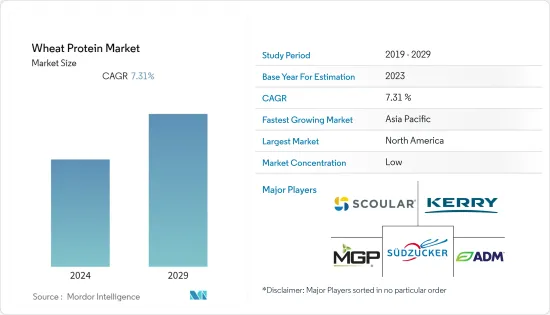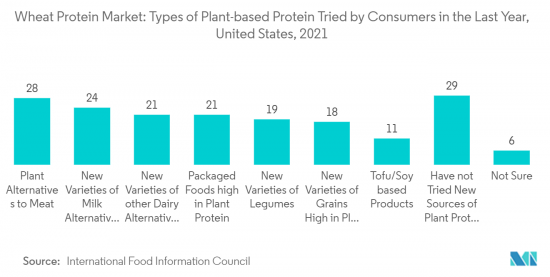PUBLISHER: Mordor Intelligence | PRODUCT CODE: 1406979

PUBLISHER: Mordor Intelligence | PRODUCT CODE: 1406979
Wheat Protein - Market Share Analysis, Industry Trends & Statistics, Growth Forecasts 2024 - 2029

The wheat protein market size is expected to grow from USD 1.13 billion in 2024 to USD 1.6 billion by 2029, at a CAGR of 7.31% during the forecast period.
Key Highlights
- A rise in demand for vegan food products primarily drives the wheat protein segment. Milk protein is one of the most commonly available proteins among others, and the increasing incidences of lactose intolerance among individuals have led to a rise in demand for alternative protein sources like wheat protein. The increasing application areas for wheat protein in the meat substitutes segment and others have also been propelling the market studied. Manufacturers operating in the market offer innovative meat alternative products, further increasing their market share.
- For instance, Archer Daniels Midland Company offers Nutriance, a range of innovative wheat protein concentrates, among its ingredients and solutions for taste, function, and nutrition. As per the company, the product delivers 85% protein and has a high glutamine content, as well as excellent digestibility, making it suitable for both the sports and senior nutrition markets.
- According to the Australian Bureau of Statistics, the gross value of poultry produced in Australia increased from AUD 2.93 billion (USD 2.1975 billion) in the year 2021 to AUD 3.18 billion (USD 2.385 billion) in the year 2022. There has been a significant increase in the demand for wheat protein applications in animal feed due to growing awareness regarding the benefit of wheat protein in animal or pet diets, which is anticipated to drive the demand for wheat protein. Moreover, significant benefits, such as high nutritional value and being a good source of several vitamins and minerals, coupled with technological advancements in the animal feed industry with growing demand for natural and organic substitutes, are expected to further drive market growth during the study period.
- Furthermore, the increasing innovations in wheat protein ingredients by various manufacturers have also been driving the global wheat protein market. For instance, in February 2022, MGP Ingredients announced the construction of a new extrusion plant in Kansas to manufacture its ProTerra line of texturized proteins.
- The USD 16.7 million facility will be located next to the company's Atchison site and will initially produce up to 10 million pounds of ProTerra per year. The new plant will assist MGP in meeting the rising demand for its ProTerra product line, which comprises pea and wheat protein ingredients used in applications such as plant-based meat substitutes. Such innovations, coupled with the rising demand for wheat protein across various end-user industries, are expected to drive the global wheat protein market.
Wheat Protein Market Trends
Inclination Towards Fitness and Increasing Intake of Plant-based Protein
- With the increasing population and welfare, the demand for protein as a food-nutritional component is rising sharply. The high protein trend is gaining traction and will continue to evoke interest in the upcoming years.
- There is a growing demand for easy-to-cook or ready-to-eat meals due to the busy lifestyle, rising healthy packaged food consumption, rising global consumption of breakfast cereal, changing dietary patterns, and an increasing number of convenience stores that are driving the demand for wheat protein ingredients among packaged food manufacturers across the globe, especially in developing countries. This gradual inclination toward a plant-based diet is largely associated with different factors, such as sustainability issues, health awareness, ethical or religious views, and environmental and animal rights.
- In a survey published by the International Food Information Council (IFIC) in the United States in 2021, almost 24% of respondents said they had experimented with new milk substitutes in the previous year. Almost 21% of respondents said they had tried packaged foods with substantial amounts of plant protein. Additionally, the easy availability of wheat protein due to the high availability of raw materials and the acceptance of the protein source have been driving the market.
- According to the International Health, Racquet & Sportsclub Association, the number of people with memberships to gyms in the United Kingdom has witnessed an increase over the past few years. The number of gym members in the United Kingdom increased from 8.28 million in 2020 to 9.57 million in the year 2021. As protein helps in muscle recovery and in maintaining muscle mass, people who are inclined towards fitness activities tend to consume more protein, and this factor, coupled with increasing demand for plant-based products, is expected to drive the market studied over the forecast period.
- Additionally, with the modified technologies, companies are targeting consumers by coming up with innovative products that have organoleptic properties like that of real meat. These meat substitutes are made with a combination of wheat and other plant proteins to attain the desired structure. The new compositional research and modified high-moisture extrusion process are helping the wheat protein market's growth.

North America Holds the Largest Market Share
- North America is the dominant region for the wheat protein market. The demand for plant proteins, including wheat protein, is primarily driven by the rising need for protein functions, awareness of diets that are high in protein, and new technical advancements. As wheat protein and other plant proteins can replicate the texture of meat, they can be used in the manufacturing of meat substitutes and are in high demand across all food and beverage categories across North America.
- Wheat proteins are proteins derived from wheat or wheat flour used in various applications, including flour milling, bakery products, pasta, meat replacer, breakfast cereal, pet food, aquafeed, milk replacer, and more. The increasing awareness of wheat protein's unique functional properties and the growing use of all vegetable proteins augurs significant market growth over the forecast period.
- Additionally, a rise in the development of dietary proteins by different manufacturers that contain a variety of amino acids and serve certain purposes, such as satiety, muscle repair, weight loss, and energy balance, is anticipated to present the market with tremendous potential growth. As per the data published by the US Department of Agriculture National Agricultural Statistics Service, with around 299.9 million bushels of wheat produced in 2022, North Dakota was listed as the state with the highest wheat production.
- In 2021, Kansas produced the most, at around 364 million bushels. This leads to the easy availability of raw materials for wheat products, which in turn leads to a reduction of prices of wheat protein among the rest of the plant-based proteins. The lower prices of wheat protein inversely affect the demand for the same, further driving the market.
Wheat Protein Industry Overview
The wheat protein market is fragmented, with the top companies owning the major market shares. The major players in this market include The Archer-Daniels-Midland Company, Kerry Group PLC, MGP Ingredients, Inc., The Scoular Company, and Sudzucker AG. The top players in the market use various strategies to strengthen their position in the market. Some of the commonly adopted strategies by the top players in the market include innovations, partnerships, and expansions. Furthermore, the companies have been investing a substantial amount of money to build cutting-edge manufacturing facilities and are expanding to new markets across the globe. Moreover, to cater to the surging demand for wheat protein owing to its numerous benefits, the players are widely focusing on augmenting their production of wheat protein.
Additional Benefits:
- The market estimate (ME) sheet in Excel format
- 3 months of analyst support
TABLE OF CONTENTS
1 INTRODUCTION
- 1.1 Study Assumptions and Market Definition
- 1.2 Scope of the Study
2 RESEARCH METHODOLOGY
3 EXECUTIVE SUMMARY
4 MARKET DYNAMICS
- 4.1 Market Drivers
- 4.1.1 Inclination Towards Fitness and Increasing Intake of Plant-based Protein
- 4.1.2 Increase in Consumer Inclination Towards Meat Substitutes
- 4.2 Market Restraints
- 4.2.1 Gluten-Intolerance Among the Population Hindering the Market
- 4.3 Porter's Five Forces Analysis
- 4.3.1 Threat of New Entrants
- 4.3.2 Bargaining Power of Buyers/Consumers
- 4.3.3 Bargaining Power of Suppliers
- 4.3.4 Threat of Substitute Products
- 4.3.5 Intensity of Competitive Rivalry
5 MARKET SEGMENTATION
- 5.1 Type
- 5.1.1 Concentrates
- 5.1.2 Isolates
- 5.1.3 Textured/Hydrolyzed
- 5.2 End-User
- 5.2.1 Animal Feed
- 5.2.2 Personal Care and Cosmetics
- 5.2.3 Food and Beverages
- 5.2.3.1 Bakery
- 5.2.3.2 Breakfast Cereals
- 5.2.3.3 Condiments/Sauces
- 5.2.3.4 Confectionery
- 5.2.3.5 Meat/Poultry/Seafood and Meat Alternative Products
- 5.2.3.6 RTE/RTC Food Products
- 5.3 Geography
- 5.3.1 North America
- 5.3.1.1 United States
- 5.3.1.2 Canada
- 5.3.1.3 Mexico
- 5.3.1.4 Rest of North America
- 5.3.2 Europe
- 5.3.2.1 Germany
- 5.3.2.2 United Kingdom
- 5.3.2.3 Italy
- 5.3.2.4 France
- 5.3.2.5 Russia
- 5.3.2.6 Spain
- 5.3.2.7 Rest of Europe
- 5.3.3 Asia Pacific
- 5.3.3.1 India
- 5.3.3.2 China
- 5.3.3.3 Japan
- 5.3.3.4 Australia
- 5.3.3.5 Rest of Asia Pacific
- 5.3.4 South America
- 5.3.4.1 Brazil
- 5.3.4.2 Argentina
- 5.3.4.3 Rest of South America
- 5.3.5 Middle East & Africa
- 5.3.5.1 United Arab Emirates
- 5.3.5.2 South Africa
- 5.3.5.3 Rest of Middle East & Africa
- 5.3.1 North America
6 COMPETITIVE LANDSCAPE
- 6.1 Strategies Adopted by Leading Players
- 6.2 Market Share Analysis
- 6.3 Company Profiles
- 6.3.1 Archer Daniels Midland Company
- 6.3.2 Cargill, Incorporated
- 6.3.3 MGP Ingredients, Inc.
- 6.3.4 Kerry Group PLC
- 6.3.5 Sudzucker AG
- 6.3.6 Roquette Freres
- 6.3.7 A. Costantino & C. spa
- 6.3.8 The Scoular Company
- 6.3.9 AMCO Proteins
- 6.3.10 Manildra Group
7 MARKET OPPORTUNITIES AND FUTURE TRENDS




